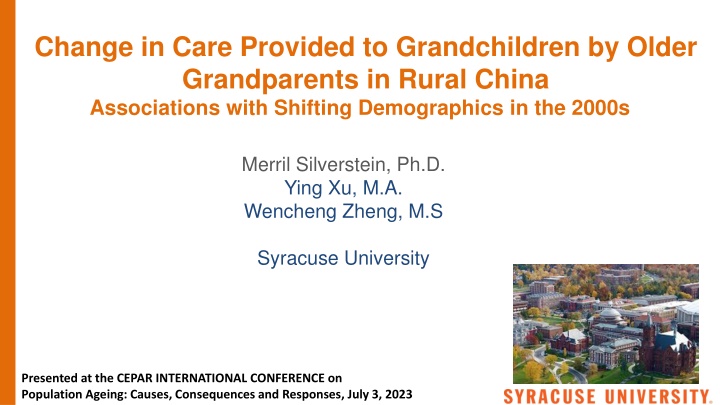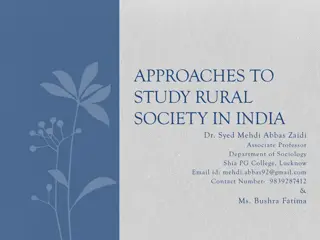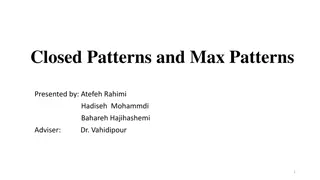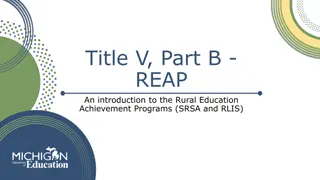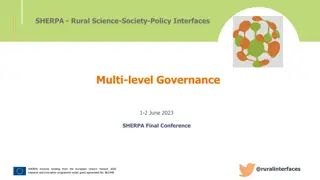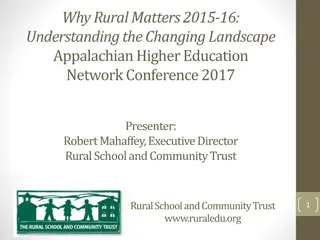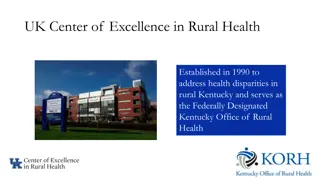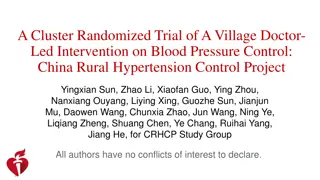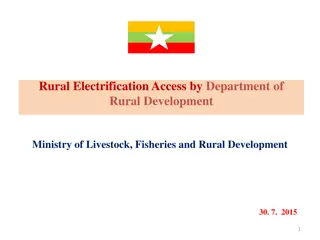Changing Patterns of Grandchild Care in Rural China: A Comparative Study
This research study explores the shifts in care provided by older grandparents to their grandchildren in rural China, examining the impact of changing family dynamics and health resources. By comparing two age-matched cohorts of Chinese grandparents 17 years apart, the study sheds light on the evolving landscape of grandchild caregiving amidst demographic transformations. The longitudinal study conducted in Anhui Province offers insights into the evolving roles of grandparents in caring for left-behind grandchildren due to rural-urban migration trends.
Download Presentation

Please find below an Image/Link to download the presentation.
The content on the website is provided AS IS for your information and personal use only. It may not be sold, licensed, or shared on other websites without obtaining consent from the author.If you encounter any issues during the download, it is possible that the publisher has removed the file from their server.
You are allowed to download the files provided on this website for personal or commercial use, subject to the condition that they are used lawfully. All files are the property of their respective owners.
The content on the website is provided AS IS for your information and personal use only. It may not be sold, licensed, or shared on other websites without obtaining consent from the author.
E N D
Presentation Transcript
Change in Care Provided to Grandchildren by Older Grandparents in Rural China Associations with Shifting Demographics in the 2000s Merril Silverstein, Ph.D. Ying Xu, M.A. Wencheng Zheng, M.S Syracuse University Syracuse University Presented at the CEPAR INTERNATIONAL CONFERENCE on Population Ageing: Causes, Consequences and Responses, July 3, 2023
Changing Conditions in China Grandparents in rural China have been documented as providing both intense and casual caregiving to their grandchildren, much of this driven by large internal rural- urban migration of the working age population and leading to left behind grandchildren. Personal and social circumstances of grandparents in China have changed in recent years, some enhancing the capacity to provide care (better health) and others reducing the demand to provide care (smaller families).
Purpose of Research To examine historical change in grandchild care by comparing two age-matched cohorts of Chinese grandparents 17 years apart To identify the extent to which historical change in grandchild care is attributable to change in family conditions and change in health and other resources of grandparents
Longitudinal Study of Older Adults in Anhui Province China Random sample of 1,798 older adults (60+) in 2001 from rural villages in Chaohu region of Anhui Province surveyed over eight waves with replenishment 2001 2003 2006 2009 2012 2015 2018 2021 Wave 1 Survey Wave 2 Survey Wave 3 Survey Wave 4 Survey Wave 5 Survey Wave 6 Survey Wave 7 Survey Wave 8 Survey
Operational Sample Two age-matched non-redundant cohorts of individuals 60- 77 in 2001 & 2018 selecting grandparents with at least one grandchild 16 years old or younger Cohort/Year N Mean Age 2001 1,185 68.2 2018 777 66.8
Significant Differences in Family Factors Between Two Cohorts of Grandparents 90 77.5 80 70.4 65.7 70 % 60 Cohort 50 2001 40 35.4 2018 30 23.6 22.6 18.3 20 10 3.7 0 Has 4+ Children Has 3+ Has Migrant Son Widowed Grandchildren per Child
Significant Differences in Resources Between Two Cohorts of Grandparents 76.1 80 70 60.2 56.2 60 % 47.7 50 Cohort 2001 40 33 2018 30 25.1 24.8 18.5 20 15.8 8.9 10 0 Functional Disabilities >3 Depressive Symptoms >5 Poor Self- Rated Health Financial Stress No Formal Education
Outcome Measure How often do you care for your grandchildren? (asked about sets of grandchildren from each adult child with at least one child <=16) Seven responses ranging from none to full-time Three categories (aggregated maximum): No care (ref) Part-time care only Full-time for at least one grandchild
Grandmother vs. Grandfather Caregivers There is little cohort change in full-time caregiving by grandfathers relative to not providing care. Qualitative research shows that grandfathers are more peripheral caregivers than grandmothers, often in an indirect supporting role or answering on behalf of their wives. Supporting this is our finding that if widowhood had not declined, grandfathers would have been significantly less likely to be a full-time caregiver in 2018. Therefore, we focus the remainder of the analysis on grandmothers.
Differences in Grandchild Care Between Two Cohorts: Grandmothers Only 60 50.7 50 45.2 40 29.0 34.2 Cohort 30 2001 % 2018 19.1 20 15.1 10 0 No Care Part-time Care Full-time Care
Analytic Technique Oaxaca-Blinder decomposition using multinomial logistic regression to attribute the percent of cohort change in care due to change in the following endowments: Change in family factors Change in resource factors Unexplained change Multinomial contrasts with no care as reference group: No care vs. part-time care No care vs. full-time care O-B decomposition posits the counter-factual of what the 2018 cohort would be if it resembled the 2001 cohort on salient endowments.
Operationalizing Cohort Change in Grandmothers Caregiving for Grandchildren Part-time Care (vs No Care) Full-time Care (vs No Care) 2001 Cohort 55.4% 31.8% 2018 Cohort 22.3% 43.0% Cohort Change (2001 2018) -33.0% +11.2%
Family and Health Variable Clusters in O-B Analysis Family variables Number of children (up to five) Number of grandchildren Presence of migrant son Health variables Sum of nine functional limitations Self-rated health Age Control variables Any formal education Widowed
Cohort (2001 2018) Change in Part-time Caregiving by Grandmothers: Endowment Effects 00% -05% -10% -15% -20% -25% -30% -35% Gross cohort change Cohort change due to change in family size Cohort change due to change in health
Cohort (2001 2018) Change in Part-time Caregiving by Grandmothers: Endowment Effects 00% -05% -10% -15% -20% -25% -30% -35% Gross cohort change Cohort change due to change in family size Cohort change due to change in health
Cohort (2001 2018) Change in Part-time Caregiving by Grandmothers: Endowment Effects 00% -05% -10% -15% -20% -25% -30% -35% Gross cohort change Cohort change due to change in family size Cohort change due to change in health
Cohort (2001 2018) Change in Full-time Caregiving by Grandmothers: Endowment Effects 12% 10% 08% 06% 04% 02% 00% Gross cohort change Cohort change due to change in family size Cohort change due to change in health
Cohort (2001 2018) Change in Full-time Caregiving by Grandmothers: Endowment Effects 12% 10% 08% 06% 04% 02% 00% Gross cohort change Cohort change due to change in family size Cohort change due to change in health
Cohort (2001 2018) Change in Full-time Caregiving by Grandmothers: Endowment Effects 12% 10% 08% 06% 04% 02% 00% Gross cohort change Cohort change due to change in family size Cohort change due to change in health
Summary Rural Chinese grandparents between 2001 and 2018 were Less likely to provide moderate amounts of care partly because of reduced family demand for their services More likely to provide full-time custodial care because of their improved capacity. Almost half of the increase in custodial care explained by health improvements.
Discussion Health, social, and economic changes in China have both reduced and enhanced grandmothers involvement in the care of their grandchildren. Overall, care has declined, pointing to reduced need for grandparent care. Health improvements explained most of the increase in custodial grandparenting. Rural Chinese grandparents are better equipped as custodial caregivers and valued assets for working children, even as opportunities for more casual caregiving have declined. Suggests that economic growth in China over the last 20 years enabled by rural-urban migration of working age population has been sustained by focusing involvement of grandmothers in the care of their left-behind grandchildren.
Thank you for listening! We thank the National Natural Science Foundation of China (71573207, 72074177) and the Fogarty International Center of the National Institutes of Health (R03 TW01060) for funding this project. Special thanks to Prof. Li Shuzhuo and his research team at Xi an Jiaotong University for their collaboration and invaluable contribution to the data infrastructure of this project.
